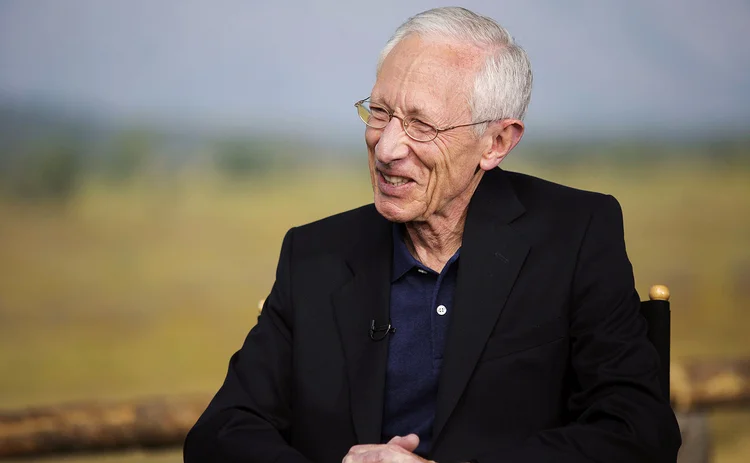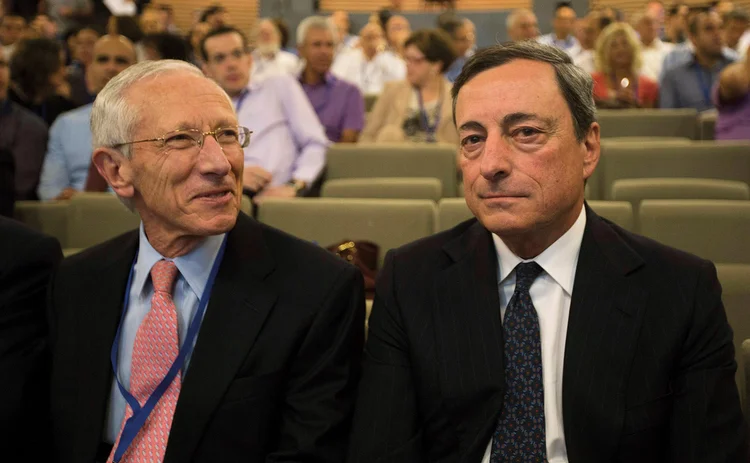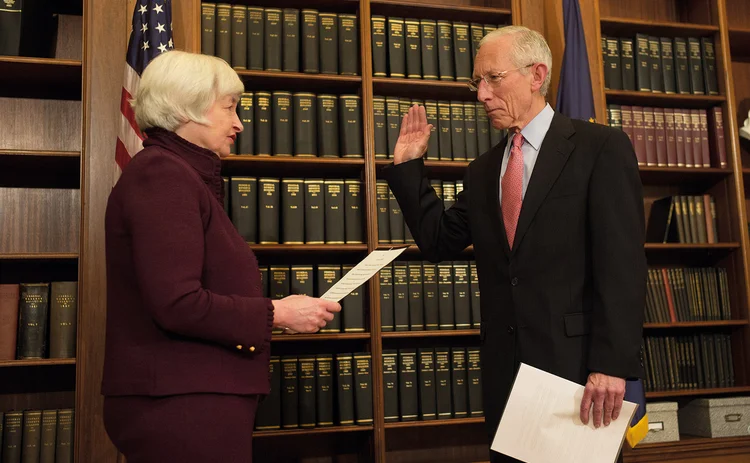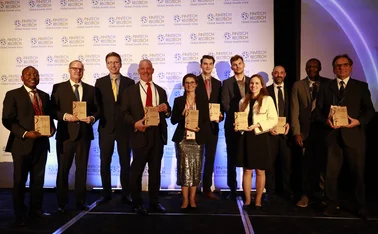
Lifetime achievement: Stanley Fischer
Fischer has had a profound impact on monetary economics and central banking during his prolific career

Stanley Fischer has had a fundamentally important impact on the world of central banking over the past half-century. This is apparent not just in one area. Fischer has stood out in at least three – as a world-leading economist and teacher, as a critical adviser to central banks and governments, and as a top-level practising central banker.
Notably, Fischer’s 1977 research offered a synthesis between monetarist and Keynesian theories. He also worked as chief economist of the World Bank and first managing director of the International Monetary Fund, during a particularly troublesome period. He also served as governor of the Bank of Israel and vice-chair of the US Federal Reserve System. In between, Fischer was a vice-chairman of Citi and subsequently an adviser at BlackRock, meaning he has also gained important commercial-sector experience. He has maintained the ability to advise on economic policy with a clear understanding of practical matters and political realities.
Overall, his footprint on the world of monetary economics, financial stability and the international financial system is wide and deep – and sometimes controversial.
Out of Africa
Fischer himself came from relatively humble beginnings. He was born in Zambia (then named Northern Rhodesia) in 1943 to a family of Latvian-Lithuanian émigrés. He grew up in the village of Mazabuka (which he would later revisit when at the IMF). He joined a Jewish youth group and travelled to Israel in 1960. It was through this movement that he met Rhoda Keet, his future wife and foremost adviser. Fischer was set to study at the Hebrew University of Jerusalem, but the self-described “product of the British Empire”, was lured instead to the centre of the ‘old world’ when he won a scholarship to study at the London School of Economics, where he earned his undergraduate and master’s degrees between 1962–66. But Fischer soon moved on to the ‘new world’ and the current centre of the world economy to earn his PhD in economics at the Massachusetts Institute of Technology in the US in 1969.

MIT was at the forefront of the development of a mathematically rigorous approach to macroeconomics at the time, and became the centre of Fischer’s life for the next quarter-century. After a brief spell as an associate professor at the University of Chicago, Fischer took on a similar position at MIT in 1973. He became a full professor of economics in 1977 until (officially) 1999, during which time he also served as head of the department of economics.
He was drawn to MIT and mentored by the late Paul Samuelson – the first US citizen to win the Nobel Prize in Economic Sciences. It was at MIT that Fischer formed a lifelong friendship with German economist Rüdiger Dornbusch (whose thesis adviser was Robert Mundell). Their textbook Macroeconomics (co-authored with Richard Startz) sold more than a million copies worldwide. Fischer said the work gave him “as much satisfaction as anything I have done in my professional life”. He also wrote Lectures in Macroeconomics with Olivier Blanchard and Economics with Dornbusch and David Begg.
New Keynesian economics
Fischer has said that he was “hooked” early on by John Maynard Keynes’s “use of language” and the knowledge that his ideas had saved “the world” during the Great Depression. So, perhaps not surprisingly, Fischer was soon to become a central figure in New Keynesian economics and, later on, wanted to implement public policy, too.
Fischer was one of the protagonists in the formation of the New Keynesian framework in the late 1970s, as the shortcomings of its predecessor, the neoclassical synthesis, became ever clearer.
The neoclassical synthesis united the assumptions of rational agents with an understanding that markets were not always competitive. Blanchard, who studied under Fischer for his PhD, said the synthesis recognised the possibility that wages and prices would not adjust quickly to clear markets. But, “somewhat surprisingly”, the neoclassical view was that wages and prices underwent a process of “tâtonnement”, or iterative movement towards an equilibrium, rather than being set by agents. Empirical observations of the Phillips curve in the 1960s seemed to lend credibility to the tâtonnement view. But the theory came increasingly under strain in the 1970s as it became clear that it was not helping policy-makers tackle spiralling inflation. Robert Lucas and Thomas Sargent declared it an “econometric failure on a grand scale”.

Two seminal papers provided the critical insight that allowed economics to move beyond the assumption of market clearing, both attacking the problem from a similar direction. John Taylor focused on sticky prices, and Fischer on sticky wages. In a 1977 paper, Long-term contracts, rational expectations, and the optimal money supply rule, Fischer demonstrated that, even in the presence of rational expectations, monetary policy had a key role to play in stabilising the economy in the short term.
“Because the money stock is changed by the monetary authority more frequently than labour contracts are renegotiated, and – given the assumed form of the labour contracts – monetary policy has the ability to affect the short-run behaviour of output, though it has no effects on long-run output behaviour,” Fischer wrote.
This elegant insight unlocked the New Keynesian paradigm that still underpins much of macroeconomics. Monetary policy can help balance out short-term fluctuations, but it cannot push the economy beyond its long-run potential. The papers by Fischer and Taylor “led the way to a major overhaul and reconstruction”, said Blanchard, which resulted in the groundwork being laid for the dynamic stochastic general equilibrium (DSGE) model by the mid-1990s.
For better or worse, the New Keynesian revolution moved economics away from the looser theoretical specifications of the neoclassical model, which “allowed the data to determine the ultimate specification”, as Blanchard put it, towards more theoretically rigid DSGE models, which “allow for a more careful welfare analysis”. DSGE models remain a critical tool in many central banks’ analytical toolkits.
A talented tradition
Blanchard, who went on serve as chief economist at the IMF, was not the only economic luminary to study at MIT, which attracted the likes of former Bank of England (BoE) governor Mervyn King. Most notably, Fischer was the thesis adviser to former Fed chair Ben Bernanke, former European Central Bank (ECB) president Mario Draghi, and former chair of the Council of Economic Advisers Greg Mankiw.
Fischer said that Bernanke, who came to MIT with an “exceptionally strong undergraduate record” from Harvard, was “outstanding” at MIT, too. When speaking about Bernanke, Fischer told Central Banking the “world owes him a lot” for averting another Great Depression. Draghi, he said, “changed the future of the European Monetary Union – the euro – with one sentence”.
MIT was consistently the top or among the top-three universities for economics in the world at the time, so attracting exceptional students. Guided by Fischer and Dornbusch, many of these students gained both economic and political economy skills needed to carry out public policy. This was built on the foundation of what Fischer described as the older, “great generation” at MIT, which included Samuelson, Bob Solow and Franco Modigliani, who Fischer said “were interested in and very good at policy”. Overall, it was a melting pot for economic ideas and their use in the real world.
Turning theory into practice
Fischer said he first experienced “serious policy work” in 1984–85 as part of a two-man advisory group on Israel’s economic stabilisation programme with then US secretary of state, George Shultz. He must have enjoyed putting theory into practice because in 1988, Fischer moved to become chief economist of the World Bank. His work there was the prelude to an even bigger job, when he was named first deputy managing director of the IMF in 1994.
Fischer arrived at the fund just a few months before the Mexican devaluation in 1994, and sat in a board meeting in early 1995 when managing director Michel Camdessus challenged the board to fire him, before ultimately securing its support to approve a $20 billion injection – a sum matched by the US Treasury – for Mexico.
Fischer himself said in 2001 that he embraced a co-operative approach to his work, aware that one of the differences between textbooks and the real world is “figuring out how to deal in complicated situations with live human beings: what is driving them, what matters to them, which incentives they will respond to, and how”. Part of the fund’s role, Fischer said, was to reinforce “people struggling under enormous pressures to do the right thing” – something he acknowledged was easier to do from the safety of Washington. Fischer also helped the fund forge closer relations with the World Bank.
Former IMF managing director Horst Köhler said Fischer had introduced a “quiet revolution” at the fund: “This included a sea change in transparency (not least for the fund itself), the work on standards and codes for good monetary, financial and fiscal policies, and an enhanced focus on financial-sector vulnerabilities.”

While at the fund, Fischer adapted a maxim from ex-president Ronald Reagan – changing “trust, but verify” to “trust, but use conditionality”. He also believed IMF teams should be “small, mean – well, tough and lean” – units that ultimately proved capable of negotiating a programme with South Korea “in a week” or designing a monetary system for Bosnia-Herzegovina “in a weekend”.
Fischer and the IMF were put to the test in 1997 when crisis hit Thailand and then spread rapidly to other Asian countries, including Indonesia, Korea, Malaysia and the Philippines. Fischer made a secret visit to Bangkok in May 1997, driving in “a van with darkened windows”. And he recalled how he saw “fear” in the eyes of central bank governors and finance ministers from the Association of Southeast Asian Nations at an October meeting that year. The strain of gaining funding for Korea in December 1997 was palpable, with efforts to secure Korean interbank credit lines only agreed on Christmas Day. Fischer also recalled meetings with the increasingly isolated Malaysian finance minister Anwar Ibrahim in May 1998.
Crises also emerged in Argentina, Brazil and Russia. But there were good times, too, including the handover of the well-governed South African Reserve Bank from Chris Stals to Tito Mboweni, the first post-apartheid governor and later financial minister.
The efforts to address the Asian financial crisis would prove to be highly contentious, with many in the region – which has largely enjoyed more than 25 years of economic progress since – and elsewhere still wary of the IMF.
There was also considerable pushback against the ‘Washington Consensus’ of 10 markets-based economic policy prescriptions considered the ‘standard’ as a reform package for underdeveloped economies. Joseph Stiglitz said transition economies should have followed a more gradualist path, learning from the success of China.
Fischer accepted that the fund’s “initial judgement” on fiscal policy “was faulty” and in the case of Thailand and Korea, calls to tighten fiscal policy were reversed. But he added there were “good reasons for the choices” the IMF had made. Fischer has also stressed that openness to trade, and sound macroeconomic policies and a market orientation has worked many times in supporting successful development.
While Fischer favoured changes in the ownership structure of the IMF to give a greater share of the voting power to nations that have grown economically “more important”, he also said countries that wanted “a bigger share in running the global economy need to accept the responsibility that comes with that”. His comments related to rules on a flexible exchange-rate system, particularly with regard to capital flows and exchange-rate management. He noted the Organisation for Economic Co-operation and Development’s code of conduct with respect to the capital account, but “some important emerging-market countries are reluctant to be bound by any codes of conduct in this area”.
Move to the private sector
After finishing his work at the IMF, Fischer joined Citigroup in February 2002 as vice-chairman and head of its public-sector group, where he is said to have earned millions in salary and stocks. It was the first time that Fischer had worked in the private sector or at an institution with 280,000 staff.
Fischer was reported to be in the running to take over as president of the Federal Reserve Bank of New York when Bill McDonough stepped down in 2003, but appeared to remove himself from the process before being interviewed for the position. A return to public service was evident on March 21, 2005, when the Israeli cabinet recommended president Moshe Katsav appoint Fischer as governor of the Bank of Israel for a five-year term.
Practising what he preached
From May 2005, Fischer set about restructuring the Israeli central bank in keeping with the sort of advice he would have given it, had he still been at the IMF.
He negotiated a change in the Bank of Israel law – which ultimately came into effect in June 2010. This set out the central bank’s primary goal of price stability via flexible inflation targeting, with secondary goals to support the economic aims of the government, particularly related to growth and employment (including social gaps), and supporting financial stability and promoting the efficiency of the financial system. A new monetary committee – comprising three members from the Bank of Israel and three external members (with the governor having the casting vote) – was established to determine policy.
Fischer viewed tackling inflation as a laser focus. “The trouble with inflation is that the process is insidious: in the short run, it rarely seems worthwhile fighting against a small rise in inflation – and that is a process that can and frequently has ended up with the economy in trouble,” Fischer told Central Banking in 2013. “So, the price anchor is very, very important.”
Fischer also moved to address a long-running labour dispute and frosty relations involving the central bank and the Treasury. And he restructured the central bank into three core departments: research; bank supervision; and financial markets (which combined domestic money markets and foreign exchange).
Fast and confident
As the global financial crisis struck in 2008, Fischer was put in a position to follow the advice he had so often given to others – to act rapidly (later, he would also move to correct problems in the financial system long before they had a chance to manifest into a crisis). Market-watchers viewed Bank of Israel decisions under Fischer’s leadership as timely and clear – and Fischer eschewed offering forward guidance.
For example, the Bank of Israel cut policy interest rates on October 6, 2008 – the day before similar moves by the US Fed, the ECB and the BoE. He also launched quantitative easing in the form of buying long-term bonds with the aim of pushing down yields and making it easier for companies to raise funds.

As the shekel started to appreciate significantly against the US dollar – a challenge for a country whose exports constitute two-thirds of GDP – the Bank of Israel started buying large amounts of foreign currency in 2008, eventually causing the shekel to fall, so supporting Israeli exports. As the central bank accumulated reserves, it overhauled its management of foreign exchange and introduced new asset classes. The Bank of Israel would also start to intervene in 2013 to offset changes in its balance of payments caused by the substitution of cheap Israeli gas for more expensive imported fuels.
In September 2009, the Bank of Israel became the first developed-economy central bank to raise interest rates after the global financial crisis – once more demonstrating Fischer’s confidence in acting quickly and decisively.
While legal authority related to macro-prudential powers proved to be more ambiguous in Israel than some other countries, Fischer encouraged their use alongside supervisory tools to curb excess lending in the mortgage sector, at a time when house prices in Israel had started to soar in a low-interest-rate environment aimed at encouraging investment and preventing excessive capital inflows.
Israeli banks had started ramping up mortgage offers, sometimes on razor-thin margins causing a rise in house prices. Fischer was all too aware that “real estate” had been “the source of many financial crises”. Absent government efforts to free up more land for housing in 2012, the Bank of Israel needed to act. It did this by restricting the availability of floating-rate mortgages to fund just one-third of all home loans, while raising bank loan-to-value ratios and increasing capital requirements held against mortgage loans.
As an economic adviser to the government, Fischer also did not shy away from speaking out against fiscal policy moves that he did not agree were in the best interests of the Israeli economy, something he did in Israel in 2011. “In the middle of 2011, it became clear that fiscal policy was going off track,” Fischer told Central Banking in 2013. “I began speaking out then”.
It was at around this time that Fischer applied for the post of managing director of the IMF to replace Dominique Strauss-Kahn, but was barred due to an IMF rule that a new managing director must not be older that 65 – Fischer was 67 at the time. Instead, he stayed on the Bank of Israel, where his work was likened to that of a “superhero” by Israeli newspaper Haaretz.
But Fischer announced his plans to step down as governor by June 2013, despite only being just over halfway through his second term. When asked about his career plans during a Central Banking interview in Jerusalem, the master strategist, with a twinkle in his eye, replied: “I’m not looking into figuring that out until I step down.” Pressed on what he made of reports that he would take on a senior position at the Fed, Fischer responded: “Well, they’re interesting to read.”
Mr Fischer goes to Washington
Fischer may have enjoyed speculation that he could take on the Fed chair role that went to Janet Yellen. But President Barack Obama instead nominated him as vice-chair of the Federal Reserve System in January 2014, with Fischer taking office as a governor on May 28, 2014, and sworn in as vice-chairman on June 16.
Fischer brought a strong international focus to the board. This was sometimes a challenge, as the Fed has statutory objectives related to specific goals linked to the US economy. Fischer reinforced the importance of the increased role of international trade to the US economy, the strength of the dollar financial system and the spillback effects of US monetary policy during several speeches.

“Although the US share of world GDP has gradually declined since the mid-20th century, the broader importance of the United States to the global economy has diminished less, or possibly not at all, as a result of increasing financial linkages over the same period,” said Fischer during a Per Jacobsson Foundation lecture in 2014.
“In a progressively integrating world economy and financial system, a central bank cannot ignore developments beyond its country’s borders, and the Fed is no exception.”
Strong rules and regulation
Although Fischer had spent time in the private sector, he favoured robust regulation to ensure the banking and financial system was less likely to fuel a future financial crisis. As a result, he criticised efforts to roll back regulations put in place after the global financial crisis. “I think that’s a mistake,” said Fischer.
He has been well aware that recessions that also include a financial crisis often get out of control. During such situations, weakened banks will stop lending, meaning the “interest rate channel becomes clogged”. His advice to avoiding such a situation was simple: “Don’t get into a financial crisis.”

Fischer praised the development of the BoE’s Financial Policy Committee as a “leading model” for financial oversight. He had also learned from his experience in Israel – a relatively small, open economy – about the tendency of global banks to withdraw capital from branches in other countries to fund themselves in their home country when they experienced tight capital, so appearing to favour subsidiarisation of foreign banks.
Fischer and independence
Fischer surprised many when he resigned from his post at the Fed for “personal reasons” on October 13, 2017 – some eight months before the expiry of his term. While taking on a position as an adviser to BlackRock and making a few speeches, he was less often seen in public, and appears to have spent more time with his family, before ultimately taking on a role as a director at Bank Hapoalim, Israel’s largest bank.
But just as he had done when he was at the Fed, Fischer strongly argued in favour of the autonomy of central banks to pursue monetary and financial stability goals. Back in 2015, Fischer said: “Central bankers have had to make use of their tools – some of them not used previously – to meet unprecedented challenges. Without the independence to pursue their mandates, this work would have been impossible.”
Fischer continued to vocalise his views at a time when Fed independence was starting to be called into question in 2017 by then-president Donald Trump. Fischer spoke out for independence based on the 20-year experience of the BoE in one of his last speeches while at the Fed. And did so succinctly two years later, after having left the Fed, during an MIT lecture: “Should a central bank be independent? The answer is yes.”
The Central Banking Awards were written by Christopher Jeffery, Daniel Hinge, Dan Hardie, Victor Mendez-Barreira, Ben Margulies and Riley Steward
Only users who have a paid subscription or are part of a corporate subscription are able to print or copy content.
To access these options, along with all other subscription benefits, please contact info@centralbanking.com or view our subscription options here: http://subscriptions.centralbanking.com/subscribe
You are currently unable to print this content. Please contact info@centralbanking.com to find out more.
You are currently unable to copy this content. Please contact info@centralbanking.com to find out more.
Copyright Infopro Digital Limited. All rights reserved.
As outlined in our terms and conditions, https://www.infopro-digital.com/terms-and-conditions/subscriptions/ (point 2.4), printing is limited to a single copy.
If you would like to purchase additional rights please email info@centralbanking.com
Copyright Infopro Digital Limited. All rights reserved.
You may share this content using our article tools. As outlined in our terms and conditions, https://www.infopro-digital.com/terms-and-conditions/subscriptions/ (clause 2.4), an Authorised User may only make one copy of the materials for their own personal use. You must also comply with the restrictions in clause 2.5.
If you would like to purchase additional rights please email info@centralbanking.com






